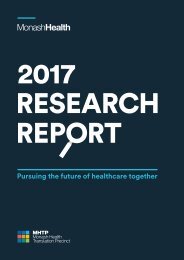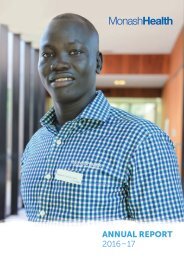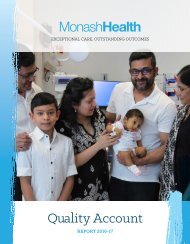Monash Health Annual Report 2018-2019
You also want an ePaper? Increase the reach of your titles
YUMPU automatically turns print PDFs into web optimized ePapers that Google loves.
The year in review<br />
01<br />
We consistently<br />
provide safe, high<br />
quality and timely care<br />
The implementation of the EMR Program<br />
is pivotal in transforming how care is<br />
provided. It will provide clinicians with<br />
access to timely information about the<br />
people they are caring for, and assist<br />
them in making decisions with easier<br />
access to best practice information.<br />
In addition to our digital strategy, we<br />
have embraced a whole-of-hospital<br />
transformation with our Transforming<br />
Care Program, enabling us to provide the<br />
best possible care and experience for<br />
our consumers. The Program comprises<br />
12 connected streams of work through<br />
leadership, teamwork and redesigning<br />
systems and processes.<br />
Our achievements in this financial year<br />
include:<br />
▪▪<br />
<strong>Monash</strong> <strong>Health</strong> was the first service<br />
in Victoria to implement the Neonatal<br />
Early Onset Sepsis Calculator to keep<br />
newborn babies with their mothers so<br />
that bonding and breastfeeding can<br />
be enhanced.<br />
▪▪<br />
<strong>Monash</strong> <strong>Health</strong> was the statewide<br />
lead for the DHHS Maternity and<br />
Newborn Rural and Regional<br />
Operating Model, to support women<br />
in determining the safest places to<br />
deliver.<br />
▪▪<br />
A Telehealth service was established<br />
across 13 adult specialties, reducing<br />
patients’ travel costs by more than<br />
$25,000 and travel by 450 hours.<br />
▪▪<br />
Hospital at Night implemented<br />
the electronic Smartpage system,<br />
improving the way clinical teams<br />
communicate patient-related task<br />
requests and evenly distribute<br />
workload at night.<br />
▪▪<br />
A single point of contact model was<br />
introduced in surgery to reduce the<br />
amount of time patients waited for<br />
elective surgery and pre-surgical<br />
appointments. This improved<br />
consumer experience and there was<br />
a seven per cent reduction in the<br />
number of patients waiting longer<br />
than clinically recommended.<br />
▪▪<br />
Mental <strong>Health</strong> continued to develop<br />
its Consumer and Family Carer<br />
Service and strengthen its Advocacy<br />
Committee with the addition of 12<br />
new members and inpatient Peer<br />
Support Workers.<br />
▪▪<br />
Our emergency department<br />
implemented an Upfront Senior<br />
Decision Making Model of Care to<br />
improve the length of stay and access<br />
to Short Stay through timely delivery<br />
of high quality, patient-centred care.<br />
This involved more efficient triage,<br />
which enabled early assessment<br />
of patients by senior clinicians and<br />
the timely development of definitive<br />
management plans.<br />
▪▪<br />
Our Diagnostic Imaging Services<br />
redesigned the Radiologist workforce<br />
from a campus, modality-based<br />
model to a subspecialty model,<br />
which is improving the quality,<br />
accuracy and efficiency of the service.<br />
▪▪<br />
Structural reporting was implemented<br />
in Perinatal Medicine and Imaging for<br />
obstetric ultrasound, improving safety,<br />
quality and efficiency.<br />
▪▪<br />
<strong>Monash</strong> Children’s Hospital gained<br />
a magnetic resonance imaging<br />
(MRI) licence, significantly increasing<br />
access to this vital technology for our<br />
youngest patients.<br />
▪▪<br />
Enhanced team-based management<br />
improved significantly, with 42 ward<br />
governance meetings established<br />
monthly. Thirty five wards now have<br />
set ward rounds and a simple set<br />
of discharge planning guidelines to<br />
ensure patients are discharged with<br />
the information and support they<br />
require.<br />
▪▪<br />
E-journey boards and patient<br />
information technology systems in 162<br />
clinical areas were established. This<br />
enabled timely and consistent visibility<br />
of individual inpatient journeys and<br />
identified delays in patient care.<br />
▪▪<br />
We introduced an internal electronic<br />
referral triage system across 46 adult<br />
and paediatric specialist clinics. The<br />
time taken to process a referral from<br />
initial receipt to booking the first<br />
appointment has been reduced from<br />
16 to six days, eliminating the need for<br />
paper and reducing the risk of losing<br />
referrals.<br />
The year in review<br />
7








